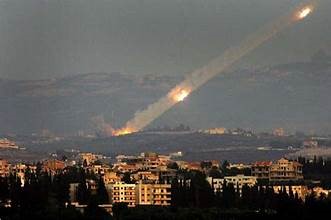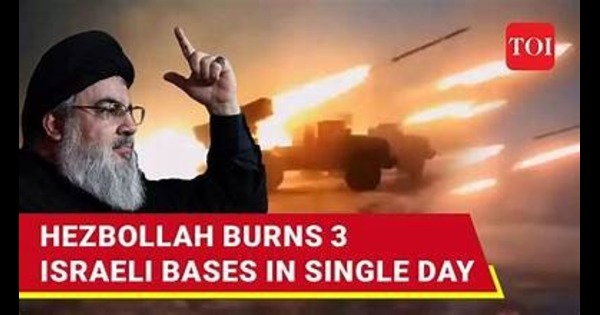Introduction
The recent attacks by Hezbollah on Israeli military bases have raised concerns about escalating violence in an already fragile region. Hezbollah, a powerful Shia Muslim political and military organization based in Lebanon, has a history of conflict with Israel, with both sides viewing each other as existential threats. This blog delves into the recent events, the motivations, and the broader implications of these attacks on the Middle East.

Background of Hezbollah-Israel Tensions
The Hezbollah-Israel conflict dates back several decades, rooted in regional power struggles and ideological differences. Hezbollah, which emerged in the early 1980s as a resistance movement against Israeli occupation in southern Lebanon, has since grown into a significant political and military force. Backed primarily by Iran, Hezbollah has expanded its influence across Lebanon and the region, frequently clashing with Israeli forces in both direct confrontations and proxy battles.
The Geopolitical Landscape of the Region
Lebanon sits at a strategic crossroads in the Middle East, bordered by Syria to the east and Israel to the south. This location has historically made it a focal point for both internal and external conflicts. Israel’s interests in the region center on maintaining security along its northern border and preventing groups like Hezbollah from gaining too much power. Meanwhile, Hezbollah’s role in the region is strengthened by alliances with Iran and Syria, both of which view Israel as a common adversary.
Events Leading to the Recent Attacks
Tensions between Hezbollah and Israel have been simmering, with recent incidents escalating hostilities. In the weeks leading up to the attacks, both sides had exchanged warnings. Israel had accused Hezbollah of amassing weapons near its border, while Hezbollah had condemned Israeli airstrikes in Syria that allegedly targeted Hezbollah supply routes. These provocations laid the groundwork for the recent confrontation.
Details of Hezbollah’s Attack on Israeli Military Bases
The recent attacks were aimed at Israeli military bases along the Lebanese-Israeli border. Hezbollah employed a combination of rocket and artillery fire, targeting specific installations believed to house Israeli defense personnel and weaponry. The attacks were reportedly well-coordinated, suggesting thorough planning on Hezbollah’s part. The targeted bases were mainly those stationed along Israel’s northern front, where tensions have historically been high.
Israeli Response to the Hezbollah Attacks
Israel’s immediate response involved both defensive and offensive maneuvers. The Israeli Defense Forces (IDF) swiftly mobilized along the northern border, launching retaliatory strikes on suspected Hezbollah positions within Lebanon. The IDF also deployed additional missile defense systems in the region to intercept potential incoming attacks. Israeli officials condemned the aggression, reinforcing the country’s stance on defending its sovereignty.
Impact on Civilians and Local Communities
The conflict has had a severe impact on civilians living near the border. Residents on both sides have been forced to evacuate or seek shelter due to fears of further escalation. Schools and businesses in border areas have temporarily closed, and many families are facing uncertainty. Humanitarian organizations are working to provide aid, but the ongoing conflict complicates relief efforts, heightening concerns for civilian safety.
International Reactions and Diplomatic Responses
The international community has responded with a mix of concern and caution. The United Nations has called for restraint from both sides, urging them to de-escalate the situation. The United States has backed Israel’s right to defend itself, while some European nations have expressed worry over the potential for a broader conflict. Key regional players like Saudi Arabia and Egypt have called for a diplomatic resolution, aiming to avoid further instability.
Hezbollah’s Motivations Behind the Attack
Hezbollah’s motivations are likely influenced by both ideological and strategic factors. Ideologically, Hezbollah views Israel as an occupying force and seeks to challenge its presence in the region. Strategically, Hezbollah may be leveraging the conflict to strengthen its position domestically and within its regional alliances, particularly with Iran, which shares a common adversarial stance toward Israel.
Israel’s Defensive Strategy and Long-Term Goals
Israel’s approach centers on securing its northern border and neutralizing threats posed by Hezbollah. The IDF has invested in advanced missile defense systems, such as the Iron Dome and David’s Sling, which are designed to intercept short- and medium-range rockets. In the long term, Israel aims to deter Hezbollah through a show of military strength and international diplomacy.
Comparing Past and Recent Conflicts Between Hezbollah and Israel
While previous conflicts between Hezbollah and Israel have seen similar levels of aggression, the recent attacks reflect increased sophistication in Hezbollah’s tactics. Over the years, Hezbollah has gained significant military expertise, often employing unconventional warfare strategies that challenge Israel’s defenses. The nature of these engagements reveals both continuity and escalation in their hostilities.
Regional Implications of the Hezbollah-Israel Conflict
This conflict has implications that extend beyond Israel and Lebanon, affecting the broader Middle East. Neighboring countries like Syria and Jordan are wary of the fallout, while Iran’s involvement in supporting Hezbollah signals potential repercussions for U.S. and Saudi interests in the region. The conflict also threatens to destabilize efforts toward peace and security in the Middle East, potentially sparking further confrontations.
Challenges in Achieving Peace Between Hezbollah and Israel
Achieving peace between Hezbollah and Israel remains a complex task, hindered by deeply entrenched political and ideological differences. Hezbollah’s influence in Lebanese politics and its reliance on Iran for support pose challenges for any diplomatic efforts. Additionally, Israel’s uncompromising stance on national security complicates negotiation efforts, leading to a persistent cycle of conflict.
Potential Outcomes and Future Scenarios
The current situation could lead to several potential outcomes. If both sides continue to retaliate, the conflict may escalate into a larger military confrontation. Alternatively, international pressure could force a temporary ceasefire, allowing diplomatic efforts to mediate. However, without a long-term solution, the underlying tensions will likely remain, posing a continuous threat to regional stability.
Conclusion
The recent attacks by Hezbollah on Israeli military bases underscore the volatile relationship between these two adversaries. While both sides have valid security concerns, the ongoing conflict poses significant risks not only to Lebanon and Israel but also to the broader Middle East. As long as ideological and geopolitical differences persist, achieving lasting peace will remain a formidable challenge.
Frequently Asked Questions (FAQs)
Q1: Why did Hezbollah attack Israeli military bases?
A: Hezbollah likely attacked as part of its ongoing opposition to Israeli influence and in response to perceived threats along the border, reinforcing its stance as a resistance movement.
Q2: How did Israel respond to Hezbollah’s attacks?
A: Israel retaliated with airstrikes targeting Hezbollah positions and increased military presence along the border to deter further attacks.
Q3: What impact does this conflict have on civilians?
A: Civilians on both sides face displacement, disrupted daily life, and heightened safety risks, especially those in border areas.
Q4: What are the implications of this conflict for the Middle East?
A: The conflict affects regional stability, involving countries like Syria and Iran and potentially influencing other geopolitical alliances and peace efforts.
Q5: Can Hezbollah and Israel achieve peace?
A: Peace remains challenging due to deep-seated ideological and geopolitical differences, with external influence from allies adding to the complexity.

